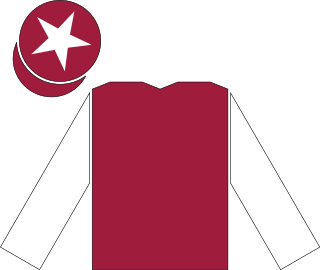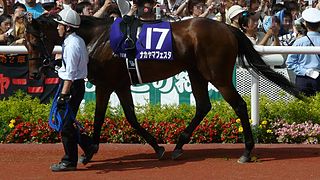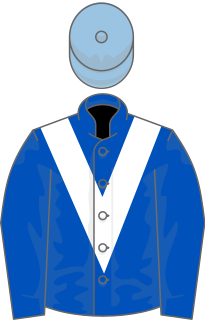
Montjeu was an Irish-bred, French-trained thoroughbred horse racing racehorse and sire. In a racing career which lasted from September 1998 to November 2000 he ran sixteen times and won eleven races. After winning twice as a juvenile, he was the outstanding European racehorse of 1999, winning the Prix du Jockey Club, the Irish Derby and the Prix de l'Arc de Triomphe. Four more victories in 2000 included the King George VI and Queen Elizabeth Stakes. He was then retired to stud where he proved to be an outstanding sire of winners.

The 1994 Prix de l'Arc de Triomphe was a horse race held at Longchamp on Sunday 2 October 1994. It was the 73rd running of the Prix de l'Arc de Triomphe.
Manduro is a World Champion Thoroughbred racehorse. He is a multiple Group One winner in Germany.
Raintrap is a British Thoroughbred racehorse and sire.
In The Wings (1986–2004) was a Thoroughbred racehorse who raced from a base in France. He was bred and raced by Sheikh Mohammed, and trained in France by André Fabre,

Nakayama Festa is a champion Japanese thoroughbred racehorse, which is most notable for winning the 2010 Takarazuka Kinen and running second to Workforce in the 2010 Prix de l'Arc de Triomphe.

Doyen is a retired Thoroughbred racehorse, who was bred in Ireland but trained in France, Dubai and the United Kingdom during a racing career which lasted from 2002 to 2005. He is best known for winning the 2004 King George VI and Queen Elizabeth Stakes.

Balanchine is a retired Thoroughbred racehorse, bred in the United States and trained in the United Kingdom and Dubai. In a racing career which lasted from September 1993 until October 1995 she ran eight times and won four races. After winning both her races a two-year-old Balanchine was narrowly beaten in the 1994 1000 Guineas before winning the Classic Epsom Oaks. She then recorded her most important success when defeating male opposition in the 1994 Irish Derby. After recovering from a life-threatening illness, she returned in 1995 but failed to win. Balanchine was one of the first important successes for Godolphin Racing.

Interpidity was a British-bred, French-trained Thoroughbred racehorse. In a racing career which lasted from April 1993 to November 1994 the filly ran twelve times and won four races. Unraced as a two-year-old, Intrepidity proved to be the outstanding three-year-old filly in Europe in 1993, winning the Prix Saint-Alary and the Prix Vermeille in France and The Oaks in England. She also finished fourth in the Prix de l'Arc de Triomphe, beaten one and a half lengths. At the end of the year she was voted European Champion Three-year-old Filly at the Cartier Racing Awards. Intrepidity was kept in training as a four-year-old, but failed to win, although she finished second in the Prix Ganay and the Prix Foy. She was then retired to stud where her record as a broodmare was disappointing.
Only Royale was an Irish-bred, British-trained Thoroughbred racehorse and broodmare. Unraced as a two-year-old, she won three times in England and twice in Italy in 1992. In the following year she was moved into the highest class and defeated the 1992 European Horse of the Year User Friendly in the Yorkshire Oaks before winning the Prix Foy in France. Only Royale won a second Yorkshire Oaks in 1994 and the Jockey Club Stakes as a six-year-old in 1995. She was also placed in the Nassau Stakes and the Coronation Cup and was unlucky in running when twice finishing just behind the leaders in the Prix de l'Arc de Triomphe. She was retired to stud at the end of 1995 and had limited success as a broodmare.
Detroit was a French Thoroughbred racehorse and broodmare who won the Prix de l'Arc de Triomphe in 1980. Unraced as a two-year-old, Detroit won her first four races in 1980 including the Prix Fille de l'Air, Prix Chloé and Prix de la Nonette. She was beaten when favourite for the Prix Vermeille before winning the Arc in record time. She remained in training as a four-year-old and won three more races including the Prix Foy. She was retired to stud where she produced the Arc de Triomphe winner Carnegie.
Acamas was a British-bred French-trained Thoroughbred racehorse and sire. The last notable horse owned by the French breeder Marcel Boussac he showed promise as a two-year-old in 1977 when he finished a close third in the Grand Critérium. He reached his peak in the following year when he won the Prix Lupin and the Prix du Jockey Club, coming from an apparently impossible position in the latter race. He then finished second in the King George VI and Queen Elizabeth Stakes in England, but was later disqualified after failing a dope test. At the end of his three-year-old season he was retired to stud but proved largely infertile.

Winged Love is an Irish-bred, French-trained Thoroughbred racehorse and sire best known for his win in the 1995 Irish Derby. After winning one of his two races as a juvenile in 1994, the colt showed steady improvement in the early part of his three-year-old season, finishing second in his first two races before winning the Listed Prix de Suresnes. He finished a close third behind Celtic Swing in the Prix du Jockey Club before reversing the form to win the Irish Derby. He went on to finish fourth in the King George VI and Queen Elizabeth Stakes and third in the Prix Niel and was retired from racing at the end of the year. He has subsequently become a successful sire of National Hunt horses.
Hernando was a French Thoroughbred racehorse and sire. He established himself as one of the best European colts of his generation in 1993 by winning the Prix Lupin, Prix du Jockey Club and Prix Niel and finishing second in the Irish Derby. As a four-year-old he won the Prix Gontaut-Biron and finished a close second in the Prix de l'Arc de Triomphe. In 1995 he won a second Prix Gontaut-Biron and was placed in both the Turf Classic Invitational and the Japan Cup. After his retireement from racing he became a very successful breeding stallion in England. He died in February 2013.
Anabaa Blue is a British-bred, French-trained Thoroughbred racehorse and sire. He was sired by the sprinter Anabaa out of Allez Les Trois, a mare with a very strong middle-distance pedigree. Between September 2000 and October 2002 he ran fourteen times and won four races. After showing moderate ability in two races as a juvenile he showed marked improvement in the following spring. After winning a minor stakes race on his debut, he won the Prix Noailles, finished a close second in the Prix Lupin and then recorded his most significant victory in the Prix du Jockey Club. He was beaten in his three remaining races as a three-year-old, but returned in the following year to win the Grand Prix de Chantilly and finish second in the Prix Foy. He was retired to stud at the end of his four-year-old season and has had some success as a sire of winners.
Sunshack is a British-bred Thoroughbred racehorse and sire who was trained in France and the United States. He showed very good form as a two-year-old in 1993 when he won two of his four races including the Critérium de Saint-Cloud. In the following year he struggled for form before ending his season with a win in the Prix du Conseil de Paris. He reached his peak as a four-year-old in 1995 when he won the Prix Jean de Chaudenay, defeated a world-class field in the Coronation Cup and then stepped up in distance to take the Prix Royal-Oak. His later career was limited by injury and he failed to win again. He stood as a breeding stallion in Japan and France with very little success.
Apple Tree is a French Thoroughbred racehorse and sire. During a racing career which lasted from September 1991 until October 1995 he competed in France, Germany, England, the United States and Japan, winning seven of his twenty-six races. After showing promise as a two-year-old he won the Prix Greffulhe and the Preis von Europa in 1992. As a four-year-old he ran prominently in several major races before winning the Prix du Prince d'Orange and the Turf Classic. He reached his peak as a five-year-old in 1994 when he defeated top-class international fields in the Coronation Cup and the Grand Prix de Saint-Cloud. After his retirement from racing he stood as a breeding stallion with limited success.
Wemyss Bight was a British-bred, French-trained Thoroughbred racehorse and broodmare. She was successful in her only start as a two-year-old in 1992 and developed into a top-class middle-distance performer in the following year. She won the Prix Penelope, Prix Cléopâtre and Prix de Malleret in France before recording her biggest win in the Irish Oaks and also finished second in the Prix Vermeille. After being retired from racing she became a successful broodmare, producing the Arlington Million winner Beat Hollow. She died in April 2009 at the age of 19.

Waldgeist is a British-bred, French-trained Thoroughbred racehorse. He has raced in six countries, namely France, Ireland, the United Kingdom, Germany, the United States and Hong Kong. He showed top-class form as a two-year-old in 2016 when he won two of his three races including the Group 1 Critérium de Saint-Cloud. He failed to win in the following year but ran second in the Prix du Jockey Club and fourth in the Irish Derby. In 2018 he won four consecutive races, namely the Prix d'Hédouville, Grand Prix de Chantilly, Grand Prix de Saint-Cloud and Prix Foy. In 2019 he won a third Group 1 race when he took the Prix Ganay and recorded his biggest win in October when he took the Prix de l'Arc de Triomphe.

White Muzzle was a British Thoroughbred racehorse and sire. After failing to win as a juvenile in 1992 he racked up five consecutive wins in the following spring including the Derby Italiano and the Churchill Stakes. Later that year he proved himself one of the best three-year-olds of his generation in Europe as he finished second to older horses in both the King George VI and Queen Elizabeth Stakes and the Prix de l'Arc de Triomphe. As a four-year-old in 1994 he again ran second in the King George VI and Queen Elizabeth Stakes and won the Grand Prix de Deauville. After his retirement from racing he became a successful breeding stallion in Japan.







